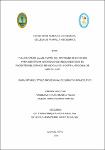| dc.contributor.advisor | Sosa Amay, Frida Enriqueta | |
| dc.contributor.advisor | López Mesia, Jhesus Jean Pierre | es_PE |
| dc.contributor.author | González Salas, Viviana Melissa | |
| dc.contributor.author | Garcia Vargas, Hilexia Corina | |
| dc.date.accessioned | 2021-08-12T21:43:21Z | |
| dc.date.available | 2021-08-12T21:43:21Z | |
| dc.date.issued | 2021 | |
| dc.identifier.uri | https://hdl.handle.net/20.500.12737/7411 | |
| dc.description.abstract | Las interacciones medicamentosas se consideran un problema que podría tener consecuencias graves. El ingreso hospitalario, la muerte, la discapacidad, la insuficiencia orgánica y las anomalías congénitas pueden ser causados por interacciones medicamentosas. Por ello el presente trabajo tiene por finalidad validar el software de Medscape para la identificación de interacciones medicamentosas en los pacientes hospitalizados del servicio de medicina del Hospital Regional de Loreto durante el año 2019. Para ello se diseñó un estudio retrospectivo en una muestra de 90 pacientes. El software Medscape presentó una sensibilidad de 79,07 %, especificidad de 94,59 %, un valor predictivo positivo de 94,44 % y un valor predictivo negativo de 79,55 %. Se determinó que el 57,78 % de pacientes presentaron interacciones medicamentosas, se identificó 150 interacciones medicamentos IDD, siendo las más frecuentes las significativas o moderadas (74%) > menores o poco probables (16 %) > severas o mayores (10%). Además el grupo de fármacos con más IDD fueron diuréticos > antihistamínicos > AINE > otros, siendo el par de medicamento más frecuente dimenhidrinato + tramadol con 6,7 %, seguido de furosemida + losartán y omeprazol + losartán cada una con 3,3% y en su mayoría son pares únicos. El software presenta una sensibilidad, especificidad, un valor predictivo positivo y un valor predictivo negativo alto; pero la evaluación de la posibilidad real de IDD queda al criterio del profesional químico farmacéutico especializado quien acompaña al médico tratante. | es_PE |
| dc.description.abstract | Drug interactions are considered a problem that could have serious consequences. Hospital admission, death, disability, organ failure, and congenital anomalies can be caused by drug interactions. For this reason, the present work aims to validate the Medscape software for the identification of drug interactions in hospitalized patients of the medicine service of the Regional Hospital of Loreto during the year 2019. For this, a retrospective study was designed in a sample of 90 patients. The Medscape software had a sensitivity of 79.07%, specificity of 94.59%, a positive predictive value of 94.44%, and a negative predictive value of 79.55%. It was determined that 57.78% of patients had drug interactions, 150 IDD drug interactions were identified, the most frequent being significant or moderate (74%)> minor or unlikely (16%)> severe or major (10%). In addition, the group of drugs with the most IDD were diuretics> antihistamines> NSAIDs> others, the most frequent drug pair being dimenhydrinate + tramadol with 6.7%, followed by furosemide + losartan and omeprazole + losartan each with 3.3% and they are mostly unique pairs. The software has a high sensitivity, specificity, positive predictive value, and negative predictive value; but the evaluation of the real possibility of IDD is at the discretion of the specialized pharmaceutical chemist who accompanies the treating physician. | en_US |
| dc.format | application/pdf | es_PE |
| dc.language.iso | spa | es_PE |
| dc.publisher | Universidad Nacional de la Amazonía Peruana | es_PE |
| dc.rights | info:eu-repo/semantics/openAccess | es_PE |
| dc.rights.uri | https://creativecommons.org/licenses/by/4.0/ | es_PE |
| dc.subject | Interacciones farmacológicas | es_PE |
| dc.subject | Software | es_PE |
| dc.subject | Aplicaciones | es_PE |
| dc.subject | Validez | es_PE |
| dc.title | Validación de la aplicación del software de Medscape para identificar interacciones medicamentosas en pacientes del servicio de medicina del Hospital Regional de Loreto, 2019 | es_PE |
| dc.type | info:eu-repo/semantics/bachelorThesis | es_PE |
| thesis.degree.discipline | Farmacia y Bioquímica | es_PE |
| thesis.degree.grantor | Universidad Nacional de la Amazonía Peruana. Facultad de Farmacia y Bioquímica | es_PE |
| thesis.degree.name | Quimico(a) Farmacéutico(a) | es_PE |
| dc.subject.ocde | http://purl.org/pe-repo/ocde/ford#3.01.05 | es_PE |
| renati.author.dni | 71977646 | |
| renati.author.dni | 72002168 | |
| renati.advisor.orcid | https://orcid.org/0000-0003-1700-2128 | es_PE |
| renati.advisor.orcid | https://orcid.org/0000-0002-1248-9363 | es_PE |
| renati.advisor.dni | 08591762 | |
| renati.advisor.dni | 45265376 | es_PE |
| renati.type | http://purl.org/pe-repo/renati/type#tesis | es_PE |
| renati.discipline | 917046 | es_PE |
| renati.level | http://purl.org/pe-repo/renati/level#tituloProfesional | es_PE |
| renati.juror | Calloapaza Valladares, Carlos Enrique | |
| renati.juror | Gonzales Diaz de Mora, Jacqueline Margot | |
| renati.juror | Ocampo Falcón, Charles | |
| dc.publisher.country | PE | es_PE |


